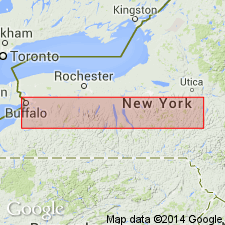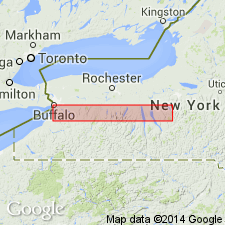
- Usage in publication:
-
- Ledyard member
- Modifications:
-
- Original reference
- Dominant lithology:
-
- Shale
- AAPG geologic province:
-
- Appalachian basin
Summary:
Pg. 218, 224, etc. Ledyard member of Ludlowville formation. Present in central and western New York. Black fissile shale, 100 feet thick, overlying Centerfield limestone (basal member of Ludlowville) on Paines Creek, Ledyard Township, Cayuga Lake. At type section is characterized by LEIORHYNCHUS LAURA and a fauna with a "Marcellus facies." Is Third LEIORHYNCHUS zone of Cleland. Overlain by Wanakah member of Ludlowville formation to west and by contemporaneous Kings Ferry member to east. Can be traced from Cayuga Lake to Lake Erie, and is coextensive with Centerfield limestone. From Lake Erie to Genesee Valley, it is overlain by STROPHALOSIA bed, 6 inches thick; from the Genesee to Cayuga Lake it is overlain by PLEURODICTYUM or MICHELINIA zone. At Lake Erie has been erroneously called Skaneateles and Marcellus, but its true position above the Centerfield can be seen on Buffalo Creek between Blossom and Elma. Age is Middle Devonian.
Source: US geologic names lexicon (USGS Bull. 896, p. 1164).

- Usage in publication:
-
- Ledyard Member
- Modifications:
-
- Revised
- AAPG geologic province:
-
- Appalachian basin
Summary:
Ledyard Member of Ludlowville Formation is here redefined. Revision makes member's stratigraphic boundaries consistent throughout the 180-km outcrop belt from Cayuga Lake westward to Lake Erie. The Ledyard varies only slightly in total thickness from 27 m at its type section to 25 m at Lake Erie. Unit is regionally uniform and consists of medium dark gray to black clay shales, calcareous concretionary layers, and thin limestone beds. Shale appears homogeneous except for beds or layers of shell material, organic-walled microfossils, discontinuous quartz silts, and diagenetic pyrite. Depositional environment interpreted as offshore within a shallow, level bottom, epeiric sea. Unit is here divided into the lower Winspear and upper Elma submembers. The Winspear is approximately 15 m thick and includes a thin limy interval at its top, the Athol Springs limestone bed, which is used to divide the two submembers. Also includes the Alden pyrite beds. The Elma is 10 to 12 m thick and contains the Bullis trilobite beds (new) and the Pond Brook interval (new), which includes the Mt. Vernon limestone bed defined by Kloc (1983). The base of the Ledyard is here defined as the top of the uppermost limestone bed of the Centerfield Member. The upper boundary of the Ledyard is placed at the base of the shell-rich PLEURODICTYUM interval as defined by Cooper (1930).
["Submember" not recognized as a formal stratigraphic rank term (CSN, 1933; ACSN, 1961, 1970; NACSN, 1983, 2005). Considered informal until formally published. The rank or lithologic term should not be capitalized.]
Source: GNU records (USGS DDS-6; Reston GNULEX).
For more information, please contact Nancy Stamm, Geologic Names Committee Secretary.
Asterisk (*) indicates published by U.S. Geological Survey authors.
"No current usage" (†) implies that a name has been abandoned or has fallen into disuse. Former usage and, if known, replacement name given in parentheses ( ).
Slash (/) indicates name conflicts with nomenclatural guidelines (CSN, 1933; ACSN, 1961, 1970; NACSN, 1983, 2005, 2021). May be explained within brackets ([ ]).

